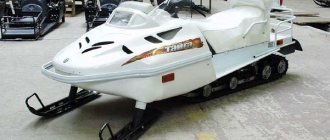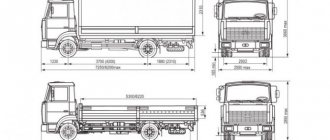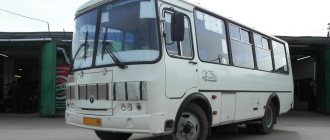Fuel consumption for Pavlovsk plant buses can be calculated using a formula approved by the Russian Ministry of Transport. The formula looks like this:
Q=0.01хHSхSх(1+0.01XD) +HOTxT, where
- Q – amount of gasoline/diesel consumed.
- S – number of kilometers traveled.
- HS - regulated fuel consumption.
- HOT – fuel consumption when the heating system is on.
- T – engine operating time.
- D – correction factor (%).
Currently, diesel and gasoline power units are installed on PAZ 32053-70 school buses. The ZMZ-5234 is used as a gasoline engine. Its volume is 4.67 liters, 130 horsepower and average normalized fuel costs are 32 liters per 100 kilometers at a cruising speed of 70 km/h.
Detailed description, device
In accordance with them, the standard value of fuel consumption should be calculated by the formula , where Qн standard value of fuel consumption, l Hs basic fuel consumption rate for vehicle mileage, l 100 km S vehicle mileage, km D coefficient is the total relative increase or reduction to the standard. While modernizing outdated models, manufacturers installed on the PAZ 32054 an all-metal carriage-type body, accommodating 38 passengers, with 20 seats.
Basic information, characteristics. Test drive Paz-3205
The designers of the Pavlovsk Automobile Plant worked hard to reduce the engine noise level, bringing it up to certification standards, but they could not completely get rid of the tractor motifs. Technical characteristics Body Supporting, carriage layout Wheel arrangement 4 2 Total number of seats 41 Number of seats 25 Maximum speed, km h 90 Control fuel consumption at 60 km h, l 100 km 19 Fuel tank capacity, l 105 Braking system pneumatic, dual-circuit with ABS Length, mm 7000 Width, mm 2530 Height, mm 2880 Base, mm 3600 Gross weight, kg 7610 Equipped with ZMZ-5234 engines.
| Options | PAZ-32053-70 |
| Body type | Carrier, carriage layout |
| Min. turning radius, m | 7,6 |
| Curb/technically permissible weight, kg | 5080…5590/6270…6780 |
| Load on front/rear axle based on technically permissible weight, kg | 2740…3100/3510…3700 |
| Total number of seats (including landing seats) | 22 (20+2 for accompanying persons) |
| Fuel tank/gas cylinder capacity, l | 95 |
| Chassis/axle | KAAZ |
| Steering gear | With hydraulic booster |
| Brake system | Pneumatic, dual-circuit, drive with axial division into circuits, with ABS |
| Ventilation | Natural, through the vents in the side windows and hatches in the roof |
| Heating system | Cabin heaters (petrol); autonomous liquid pre-heater and cabin heaters (diesel) |
| Tires | 8.25 R20 |
| Base, mm | 3600 |
Appearance - Specifications
The lower part of the central false radiator grille is not original Pre-styling PAZ-32053 in Nozhkino, Kostroma region Pre-styling PAZ-32054 with a late light gray false radiator grille in Tomsk School PAZ-32053, Pervomaiskoe village, Tomsk region PAZ-32053, rear view PAZ-32054 restyling 2014 Gas life-saving bus based on PAZ-32053 PAZ-3205. improvement of interior design, installation of an incomplete partition between the driver's seat and passenger seats, upholstery of seats in artificial leather, installation of a protective door strip;
| PAZ 32031-01 (driver 23 seats; Cummins 4ISBeB150) | 150 | 3,92 | 22.7D |
| PAZ 320401-01 (horizontal 52 seats; Cummins B3.9-140) | 140 | 3,92 | 23.7D |
| PAZ 320401-01 (suburban 37 seats; CumminsB3.9-140) | 140 | 3,92 | 22.1D |
| PAZ 320401-03 (driver 26 seats; Cummins ISBeB185B) | 183 | 4,461 | 22.5D |
| PAZ 320402-03 (horizontal 43 seats; Cummins ISBeB185B) | 185 | 4,461 | 21.4D |
| PAZ 32053 (led. 25 places; ZMZ-523400) | 130 | 4,67 | 32,1 |
| PAZ 32053 (approx. 41st place; ZMZ-5234.40S) | 125 | 4,67 | 30,9 |
| PAZ 3205-30 (led 25 seats; ZMZ-511) | 125 | 4,25 | 30,2 |
| PAZ 32053-70 (led 23 m; ZMZ-523400) | 130 | 4,67 | 32,4 |
| PAZ 320538-70 (school 22 places; ZMZ-5234) | 130 | 4,67 | 31,6 |
| PAZ 3206-110-60 (led 25 seats; ZMZ-52340S) | 124 | 4,67 | 30,4 |
| PAZ 3206-110-70 (school 26 seats; ZMZ-5234) | 130 | 4,67 | 32,9 |
| PAZ 3237-01 (horizontal 55 seats; Cummins 4ISBe B150) | 150 | 3,92 | 29.6D |
| PAZ REAL (led 23 seats; Hyundai D 4AL) | 117 | 3,298 | 21.1D |
| PAZ REAL (led 23 seats; Hyundai D4DD) | 140 | 3,907 | 23.7D |
| PAZ buses until 2008 | ||
| Model | Fuel consumption rate, l/100 km | Type of fuel |
| PAZ-3201, PAZ-3201S, -PAZ 320101 | 36,0 | B* |
| PAZ-3205, PAZ-32051 (with engine ZMZ-672-11) | 34 | B* |
| PAZ-3205 (suburban 37 seats) | 31,2 | B |
| PAZ-3205 (suburban 37 seats) (ZMZ-5234.10-8V-4.67-130-4M) | 32,0 | B |
| PAZ-3205-70 (nearby) | 20,9 | D |
| PAZ-32051 (m/g 42 seats) | 29,0 | B |
| PAZ-32051 (m/g 42 seats) (ZMZ-5234.10-8V-4.67-130-4M) | 29,8 | B |
| PAZ-32053 (driver 16 seats, AI-80) | 31,6 | B |
| PAZ-32053 (driver 16 seats, AI-92) | 30,3 | B |
| PAZ-32053-07 (horizontal 37 seats) (D-245.9-4L-4.75-136-5M) | 24,4 | D |
| PAZ-32053R (suburban 37 seats) | 23,2 | D |
| PAZ-32054 (horizontal 38 seats) | 35,4 | B |
| PAZ-320540 (m/y 41st place) | 29,9 | B |
| PAZ-3206 (with engine ZMZ-672-11) | 36,0 | B* |
| PAZ-3206 (suburban 29 seats) | 32,1 | B |
| PAZ-3206 (suburban 29 seats) (ZMZ-5234.10-8V-4.67-130-4M) | 33,0 | B |
| PAZ-3237 (horizontal 55 seats) | 28,5 | D |
| PAZ-4230-02 “Aurora” (m/y 32 seats) | 24,2 | D |
| PAZ-4230-03 “Aurora” (27 seats) (D-245.9-4L- 4.75-136-5M) | 25,6 | D |
| PAZ-4230-03 (horizontal 56 seats) (D-245.9-4L-4.75-136-5M) | 26,7 | D |
| PAZ-4234 (suburban 50 seats) (D-245.9-4L-4.75-136-5M) | 23,9 | D |
| PAZ-423400 (led 50 seats) (D-245.9-4L-4,75-136-4M) | 24,6 | D |
| PAZ-5272 (horizontal 104 seats) (KaMA3-740.11-8V-10.85-240-5M) | 36,5 | D |
| PAZ-5272 (led. 43 places) (KAMAZ-740.11-8V-10, 85-240-5M) | 32,4 | D |
| PAZ-672, PAZ-672A, PAZ-672G, PAZ-672M, PAZ-672S, PAZ-672U, PAZ-672Yu | 34,0 | B* |
| PAZ buses since 2008 | |||
| Model | Engine power, hp | Working volume, l | Fuel consumption rate, l/100 km |
| 1 | 2 | 3 | 4 |
How many seats are in a large single-decker bus and how many seats are in a double-decker bus?
At idle speed, the engine noise is almost inaudible, but the pneumatic compressor produces a characteristic sound similar to the screeching sound of a black grouse. At higher speeds, the engine makes itself felt, drowning out the pneumatic compressor, reminiscent of the good old GAZ-53 truck.
| Options | ZMZ-52342.10 | YaMZ-534 | MMZ D-245.9 |
| Options | ZMZ-52342.10 | YaMZ-534 | MMZ D-245.9 |
| Type | Gas engine | Diesel engine | Diesel engine |
| Number and arrangement of cylinders | 8, V-shaped at an angle of 90˚ | 4R | 4R |
| Environmental safety standards | Euro 4 | Euro 5 | Euro 5 |
| Working volume, l | 4,67 | 4,43 | 4,75 |
| Engine power, kW (hp)/min | 90 (122.4) at 3200 min-1 | 99 (134.6)/109.5 (148.9) at 2300 min-1 | 95.5 (129.8) at 2400 min-1 |
| Max. torque, Nm/min | 288 at 1600…2000 min-1 | 422 at 1200…2100 min-1/583 at 1300…1600 min-1 | 455 at 1200…1600 min-1 |
| Engine location | Anterior longitudinal | Anterior longitudinal | Anterior longitudinal |
| checkpoint | Manual transmission: GAZ-3307, 4 or 5 speed. | Manual transmission: S5-42, 5-speed, FastGear 5DS60T, 5-speed. | Manual transmission: SAAZ 3206, 320670 5-speed. |
| Maximum speed, km/h | 60 | 60 | 60 |
| Bus warranty | 2 years or 60 thousand km | 1.5 years or 75 thousand km | 1.5 years or 50 thousand km |
*All technical specifications are for informational purposes only, please check the exact details by calling the numbers listed in the “Contacts” section.
History of the enterprise. • History of creation
| Online calculator: Standard fuel consumption value. Buses, domestic and CIS countries In 2007, production was modernized, which made it possible to carry out certification for regular use on busy routes, the service life of the body has significantly increased from 5 to 10 years, a more efficient heater and more comfortable seats are installed in the cabin. Insulated version of the bus for northern regions Double glazing of windows or double glazed windows, insulation of sidewalls, roof, hatches, floor Body paint Basic white. |
| Bus PAZ-4234: history of creation, description, modifications, basic, technical and additional parameters, engine and chassis characteristics, advantages I work on the PAZ-32054 bus of the 1995 model year, which originally belonged to the carrier, and after retirement I bought it for half the cost. Over time, new models appear, adapted to modern passenger requirements, and also very competitive on the market in comparison with European products. |
Bus PAZ 32053 fuel consumption • It is enough to ensure that the level of working fluids does not fall below the minimum mark, and to comply with all the manufacturer’s requirements.
Standard value of fuel consumption. Buses domestic and CIS countries
Calculation of fuel consumption in accordance with the methodological recommendations “Standards for the consumption of fuels and lubricants in road transport”, introduced by the order of the Ministry of Transport of the Russian Federation dated March 14, 2008 N AM-23-r.
The calculator below attempts to calculate fuel consumption in accordance with the methodological recommendations “Standards for the consumption of fuels and lubricants in road transport”, introduced by order of the Ministry of Transport of the Russian Federation dated March 14, 2008 N AM-23-r.
The calculator was created upon request to calculate fuel consumption for. , you can also read a short discussion of the problem there.
It is clear that it is best to read the specified methodological recommendations (they are everywhere on the Internet), but for the lazy, I will briefly outline the essence of the matter. Recommendations are needed to assess fuel consumption when operating vehicles. For each vehicle model there is a basic norm, expressed in liters per 100 kilometers. For example, for domestic buses it can be found in the reference book that I made specifically for this calculator - Standard fuel consumption value. Buses domestic and CIS countries.
But life, as we know, makes its own adjustments. It is these adjustments that are trying to take into account the methodological recommendations. In accordance with them, the standard value of fuel consumption should be calculated according to the formula, where Qн is the standard value of fuel consumption, l Hs is the basic rate of fuel consumption per vehicle mileage, l/100 km S is the vehicle mileage, km D is the coefficient (total relative increase or decrease ) to normal, %
The correction factor is the sum of all currently applicable factors. For example, when vehicles operate in winter, depending on the climatic region, the norm can increase from 3 to 20%. See the value of winter surcharges to fuel consumption standards for regions of Russia, depending on climatic regions. The same is true when operating a car in high mountains, in a big city, and so on. The idea, I think, is clear.
For buses, the situation is a little more complicated due to the need to take into account fuel consumption for heating the interior. An additional term appears in the formula, where No is the fuel consumption rate when using standard independent heaters to operate the heater(s), l/h T is the operating time of the vehicle with the heater on, h Data for some brands are given here Fuel consumption rates for heating bus interiors and car cabins with independent heaters.
Since the guidelines recommend that for vehicles and brands of heaters not listed in them, the calculation of fuel consumption should be carried out according to the manufacturer’s data, I have provided the opportunity to enter my data. If in the “Or enter the consumption rate for the heater operation” field, enter a number other than zero, then it will participate in the calculations; if you leave zero, then the data is based on the heater table.
For non-obvious parameters, a tooltip appears if you hover the mouse over the text of the parameter, for example, there is such a tooltip for the parameter “Work on public roads with a complex layout.”
The maximum coefficients from the recommendations are taken, and only those that, in my opinion, can be applied to buses are used. So comments and suggestions are welcome.
Design Features...Technical Specifications
| PAZ-32054 real reviews about fuel consumption Various types of engines have been installed on the bus throughout the history of production, among which the most common is the carburetor gasoline engine ZMZ-5234, diesel MMZ-245. On these modifications, factory installation of gas-cylinder equipment for operation on liquefied petroleum gas or compressed natural gas began. |
Photo by Pazik • The fuel tank, as on the base model, is 105 liters.
Location of seats on a long-distance bus. Schemes of the most popular ones
Owners of trucks usually focus on the optimal value; maintaining it ensures a long service life of the tires and economical fuel consumption. 9 ZMZ-5245 Type Gasoline engine Diesel engine Diesel engine Gas engine Number and arrangement of cylinders 8, V-shaped at an angle of 90 4R, vertical 4R, vertical 4R, vertical Environmental safety standards Euro-4 Euro-5 Euro-5 Euro-5 Working volume, l 4.67 4.43 4.75 4.43 Engine power, kW l.
PAZ-32054 real reviews on fuel consumption
PAZ-32054 fuel consumption per 100 km.
PAZ-32054 is a small class bus developed in the 1990s. This model is considered one of the most popular in post-Soviet times. The main distinguishing feature compared to its predecessor is the two-door body design, as well as other technical innovations. Thanks to gradual modernization, the bus has become more reliable and durable. The service life and consumer characteristics have improved. Production of PAZ-32054 began in 1989. Over the years, many modifications of this model have been made, which is still in high demand. The car broke the “longevity” record of its predecessor called PAZ-672. There is also a more advanced model PAZ-3203, but they decided to abandon its production due to its expensive design.
Modifications[ | ]
In conclusion, I would like to note that the specialists of the Pavlovsk Bus Plant have made a big step forward in six years. New PAZ-4230 “Aurora” buses of various modifications with a rear-mounted power unit are already running on the roads of the country. In the center of Moscow, passengers are served by low-floor PAZ-3237; New front-engine small class buses PAZ-3203 and PAZ-3204 are being produced in small batches and undergoing certification tests. In general, PAZ does not stand still, but is systematically integrated into the modern Russian bus market with its new model range. However, the old PAZ model and its modifications are still in demand on the market. The “people's” bus continues to be purchased for use in a wide variety of road and climatic conditions. The forecast for the future is this: the car will be in demand for a long time, especially since work on its development has never stopped. Despite its outdated design, Russians like the PAZ-3205. And we can’t sell it to Germany, Spain, Sweden or Finland. There are enough of their own “people’s” buses there even without “grooves”.
Specifications
While modernizing outdated models, manufacturers installed on the PAZ 32054 an all-metal carriage-type body, accommodating 38 passengers, with 20 seats. For PAZ vans operating without taking into account the weight of the transported cargo, the normalized value of fuel consumption is determined taking into account an increasing correction factor of up to 10 to the base standard.
In the gaming and souvenir industry[ | ]… Technical parameters groove 32054
| PAZ-32054 - we explain from all sides In the 1970-1980s, the Soviet Union carried out significant volumes of supplies of self-propelled chassis based on the PAZ-672 bus to Cuba, where the customer mounted their bodies on it. It differs from standard buses in the installation of soft non-adjustable seats in the cabin on the podium superstructure, the presence of luggage racks above the seats along the windows and a luggage compartment with a volume of about 2 m in the rear of the cabin. |
- diesel unit MMZ-245.9, power - 136 hp. With.;
- brakes - drum type with dual-circuit pneumatic drive and Knorr Bemse anti-lock system;
- bridge - KAAZ;
- rigid spring-type suspension.
Engine/Powertrain Specifications Basic Specifications
| PAZ 32053-7. “School bus” Parameters PAZ-32053 54 PAZ-32053 54 CNG LPG Length Width Height, mm 7000 2500 2890 class I-II, 2960 class II 7000 2500 2890 class I-II, 2960 class II Number of doors width, mm 1,726, 1 emergency 600; 2,726 1,726, 1 emergency 600; 2,726 Ceiling height in the cabin, mm 1965 1965. The bus is equipped with a dual-circuit brake system with drum mechanisms on all wheels and ABS, a steering system with power steering, and a fuel tank with a capacity of 95 liters. |
| PAZ-32053 - Wiki It just so happens that domestic vehicles are not highly reliable, and malfunctions of various components and assemblies quite often catch the driver on the road. It’s easy to guess that the PAZ-3206 borrowed the main units of the all-wheel drive transmission from Gorky trucks, first from the GAZ-66, and later from the GAZ-3308. |
- Home page
- The lineup
- PAZ-32053-70 school
- Specifications
Example of work performed • 4 horsepower at 3200 rpm and 288 Nm of torque at 1600-2200 rpm.











